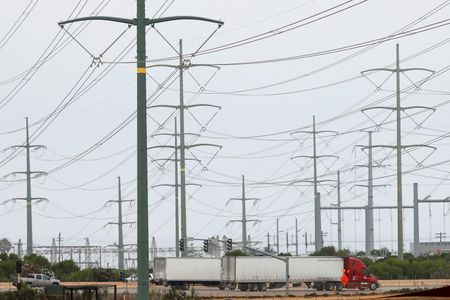
(Reuters) -California’s grid operator projected record-breaking power demand on Tuesday and issued an emergency call for consumers and businesses to conserve energy for the seventh consecutive day to avoid blackouts amid soaring temperatures.
The California Independent System Operator (ISO) urged residents to conserve power in the late afternoon and early evening as the sun sets and the state’s vast supply of solar-generated electricity recedes.
Late in the afternoon, the grid operator raised its emergency alert level to tap into programs that offer financial incentives to reduce energy use and seek more electricity from the market. It said it would likely raise the alert level again, a step closer to implementing rotating outages.
California’s week-long run of record-breaking temperatures is projected to continue this week with highs reaching into the 110s Fahrenheit (mid 40s Celsius) in interior parts of the state, according to the National Weather Service.
In Sacramento, the state’s capital, the temperature reached 115 Fahrenheit (46.1 Celsius) on Tuesday afternoon, its highest ever.
“I know this has been a very long heat wave and we’re not asking you to do even more,” Elliot Mainzer, CEO of the ISO, said in a video recording posted on Twitter. “But please stick with us and don’t use any more power than is absolutely necessary.”
The ISO forecast demand would peak at 51,698 megawatts (MW) on Tuesday, topping the current record of 50,270 MW in 2006, before sliding to 49,868 MW on Wednesday.
Late on Tuesday afternoon, solar power was supplying about a fifth of the state’s power demand.
If demand for power exhausts the grid’s electric reserves, the ISO said it would instruct utilities to start imposing rotating outages. It would be the first time the state has taken such a measure since a brutal heat wave in August 2020 forced power cuts over two days to around 800,000 homes and businesses.
U.S. power prices in California and other western states for Tuesday soared to their highest since that 2020 heat wave.
Power prices at the Palo Verde hub in Arizona and SP-15 in Southern California rose to $850 and $505 per megawatt hour, respectively. That was their highest since hitting record highs of $1,311 in Palo Verde and $698 in SP-15 in August 2020 when the ISO last imposed rotating outages.
(Reporting by Scott DiSavino in New York and Nichola Groom in Los Angeles; Editing by Sandra Maler)

